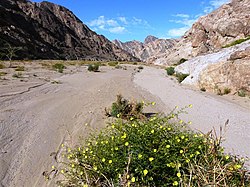| Khan River | |
|---|---|
 | |
 | |
| Physical characteristics | |
| Source | Otjisemba, northwest of Okahandja |
| • location | Otjozondjupa Region |
| • coordinates | 22°42′S14°54′E / 22.700°S 14.900°E |
| Mouth | Swakop River |
• location | c.40 kilometres (25 mi) east of Swakopmund |
| Basin size | 8,400 km2 (3,200 sq mi) |
| Basin features | |
| Tributaries | |
| • right | Slang River, Etiro River |
The river Khan is an ephemeral river crossing the Erongo region of central Namibia. It is the main tributary of the Swakop River [1] and only occasionally carries surface water during the rainy season from November to February/March. Khan's catchment area including its tributaries Slang and Etiro stretches over 8,400 square kilometres (3,200 sq mi). [2]
The Khan has its origin near the settlement of Otjisemba, north-west of Okahandja. From there the river course passes westwards to the town of Usakos, and further in a south-western direction through the Namib desert. It has its confluence with the Swakop River 40 km east of Swakopmund. [3]
It is a popular tourist attraction due to the proliferation of mammals such as the klipspringer antelope, [4] ostriches and jackals.